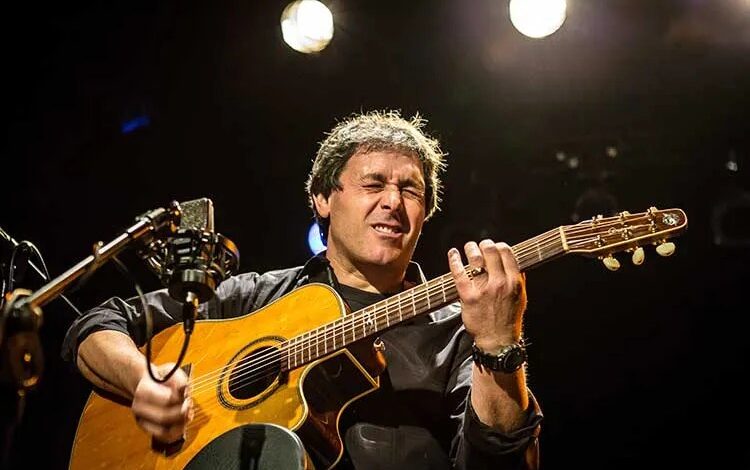Fingerstyle Composer Peppino D’Agostino Connects the Steel-String Guitar Worlds

Since the ’80s, Peppino D’Agostino has created an expansive vision of the acoustic guitar as a concert instrument, tapping into not only the steel-string’s native idioms of folk, blues, and country but also nylon-string traditions from Italy, Spain, and Brazil. Like many fellow explorers of fingerstyle guitar, D’Agostino uses unorthodox tunings, percussion, and other extended techniques to open up new vistas on the instrument. Yet his guitar compositions feel driven, first and foremost, by melody—not fingerboard acrobatics.
Originally from Italy, D’Agostino started out in the U.S. as a street musician and restaurant guitarist in San Francisco. He still makes his home in the Bay Area, touring internationally with his signature Seagull guitar. D’Agostino’s discography attests to his diverse interests, including collaborations with classical guitarist David Tanenbaum, Italian songwriter and pop producer Corrado Rustici, and electric rock guitarist Stef Burns. D’Agostino’s most recent album, Connexion, showcases his range and mastery as a player/composer.
In addition to his performing career, D’Agostino is a prolific teacher, creating lessons in recent years for TrueFire and Guitar by Masters, as well as interactive scores through Interlude. With his wife, Donna, he runs Music World Retreats, which offers music camps in the U.S. and Europe for guitarists as well as mandolin, ukulele, and violin players. Upcoming guitar events include a Martin Taylor retreat in California and a bluegrass immersion in Sicily with Bryan Sutton and Chris Eldridge.
I caught up with D’Agostino by phone to learn more about his latest travels with guitar.
When you were learning to play in Italy, was there a specific artist who drew you into instrumental steel-string guitar music?
You know, when I started, I used to play electric guitar—I was a big fan of [John] McLaughlin and some of the early Santana, that kind of stuff. But then somebody brought a record from the U.S. in 1974: it was John Fahey, Leo Kottke, and Peter Lang on Takoma Records. The music was really undefinable. It was not blues, it was not country—it was different. I was immediately attracted to that and started, like people in my generation, to try to replicate it. Of course there was just the turntable at that point, so, you know, up and down with the needle.
The funny part is that I didn’t know about open tunings. I was trying to recreate what Leo and Peter Lang and Fahey were doing using standard tuning, so of course I went mad. But then maybe I read somewhere about changing the tuning.
Did you discover other instrumental guitarists at the time as well?
I’ve been always very interested in many different styles, and for the Chet Atkins, Jerry Reed, Lenny Breau fingerstyle, I have to give credit to [French guitarist] Marcel Dadi. He was playing Chet Atkins songs, and inside the vinyl there were always the tabs.
At that time also, Stefan Grossman was living in Italy, and I remember going to visit him. He was living close to Rome, and he had this label called Kicking Mule. That’s how I discovered people like John Renbourn and Dave Evans, who I think was a genius. There’s an album called Sad Pig Dance that is gorgeous.
Compared with a lot of instrumental guitarists, you focus much more on melody. Does melody guide your composing process?
In general, yes. I think it’s because I grew up singing Italian songs that are very melodic. When I started playing guitar, I was playing the chords and accompanying my voice because that’s what my peers wanted, so that transferred later on when I started writing instrumental music.
You know, as I’ve evolved as a musician, I use all elements. For instance, there’s a piece called “Jump Rope” that was mainly inspired by emphasizing the upbeat. With another piece, “Beyond the Dunes,” I was very inspired by a 7/8 time signature. So [in those examples] I developed something based on rhythm.
Acoustic guitar is such a naturally rhythmic instrument that you need real sensitivity to develop strong melodies.
What’s interesting is that I think it’s connected with open tunings. We all know that DADGAD is very popular, but I use tunings that are really strange. I think I do that so I don’t fall into patterns, and it’s connected to melodies. For instance, there’s a piece that I wrote called “Nine White Kites” with a very strange tuning that is C# G# E F# B D#, so it’s a C# minor sus. And playing in that tuning is kind of like stepping in the dark. You don’t know scales, chords. I was just following my fingers and what they found on their own. Because of the obscurity of this tuning, I was able to find that melody.
Does it ever work the other way around, where you have a melody in your head and find a tuning that helps you play it?
No, but you just gave me a good idea!
Recently, I’ve been thinking of using technology like [the notation software] Sibelius: just go to the score and manually move the notes, and then transfer to the guitar. [Brazilian guitarist and composer] Sérgio Assad does this a lot actually.
Are there any tunings you’ve discovered recently that you particularly like?
Yeah, there’s one that a combination of two chords. The sixth, fifth, and fourth strings are F, A, and C, so there you have an F major chord. Then the third, second, and, first are E, G, C, which is a C chord. So it’s a combination of F major and C major. That’s the tuning that I use on a piece called “Dancing with Shadows,” which is on my latest album. I’m going to try more of that in the future, when you basically have two different chords together near each other.
There is often such a divide between the nylon- and steel-string guitar worlds in terms of technique, repertoire, and teaching approach, but you’ve crossed over quite a bit. What have you learned from the nylon-string or classical side that informs what you do on steel-string?
I’ve been lucky enough to play with great classical players such as David Tanenbaum and Sérgio Assad—these are really some of the best players in the world. Marc Teicholz also, who is part of the faculty at San Francisco Conservatory of Music.
What I’ve learned from classical musicians is the attention to the details. They dedicate their lives to how they deliver the notes, if a note is played open or on [a fretted] string . . . There’s always a reason behind how they play. That’s something you don’t see often in the acoustic guitar world—that level of precision and dedication to the cleanness of notes and also to the delivery.
The other thing is, with contemporary compositions on classical guitar, I think there’s a lot more harmonic depth than in the acoustic guitar world. Harmonically there’s a lot more exploration, which is inspiring to me instead of just staying within six or seven chords.
Let’s talk about your guitars a bit. Have there been any changes to what you’re using onstage or for recording?
Essentially, my main instrument is my [Seagull] signature model that I developed with Robert Godin about 30 years ago. It’s a six-string guitar with a wider neck. They worked for two or three years with a university there in Montréal to create bracing that makes the instrument very balanced between the bass, midrange, and treble. This is the guitar I use live and in the studio.
Has the guitar evolved at all over the years?
Yes, as far as the bracing and also the look. It’s now bourbon, a dark color, and aesthetically we really like it. Pretty soon actually, Godin will come up with the 30th anniversary of my guitar. It will be a student model, and it’s going to be less expensive, so I’m looking forward to seeing what they come up with.
Also, this is an electro-acoustic instrument. The latest model has an L.R. Baggs Anthem pickup, which I’m very happy with, although in certain situations I play just acoustically [with a mic]. Maybe this is the influence of classical guitarists—they don’t like to use anything.
It’s a different kind of approach when you use only a good condenser microphone. The acoustic sound is closer to reality. If you plug in, it becomes something different—beautiful, but different.
With Music World Retreats, you host a variety of music camps, including some focused on fingerstyle guitar. Many fingerstyle players are solo oriented—they are not necessarily accustomed to playing with other people. Is part of the camp bringing people together to experience music in a more social way?
I love this question. You know, one of the places where we bring the Music World Retreats is to Sicily. In August, the first one was a mandolin retreat with Mike Marshall and Caterina Lichtenberg. Mandolin players, they play together all the time. At nights, we usually go to this gourmet restaurant, and the chef is really funny. Every night with the mandolin players, at the end of the dinner, after lots of wine and stuff, everybody was happy and they all played together, right? The following week, we had the fingerstyle workshop with Adam Rafferty and myself. We went to the same restaurant and the chef came to me and he said, “Boy, this is a different kind of group. They’re serious, you know? They don’t play together!”
I’m really aware that fingerstyle guitarists are usually in their room—it’s a lonely one-person experience. But I try to break that in these workshops. For instance, Adam Rafferty created an ensemble of Bach pieces with four parts, so that they can all play together. And I even made an arrangement of Joe Zawinul’s “Mercy, Mercy, Mercy” with four parts. So we push the students to experience what playing together means, because a lot of them don’t know and some are really shy. But when we encourage them, you can see how much fun they have.
What He Plays
Peppino D’Agostino plays his signature Seagull guitar, known as the Peppino Signature CW, which has an extra-wide neck (1.9 inches at the nut) that’s nearly as wide as on a classical guitar.
When he plugs in, he uses an L.R. Baggs Anthem pickup through a Baggs Venue DI that allows him to run a separate amp output onstage and have more control over his stage volume. When he performs with a mic only, he uses an AKG 460 pencil condenser.
He uses Dunlop 80/20 bronze light gauge strings (.011–.052) that he changes for every show.
He sometimes uses a Dunlop thumbpick, depending on the music. “If I play a classically oriented piece, I use the pad of my thumb to have more control of the volume, expression, and dynamics,” he explains. “If I play fast bluegrass, pop, country, or ragtime and I need to muffle the bass string sound, then I’ll use the Dunlop thumbpick. In addition, I rest the side of my right hand near the bridge to damp the sixth, fifth, and sometimes the fourth strings.” —JPR
This article originally appeared in the March/April 2024 issue of Acoustic Guitar magazine.




